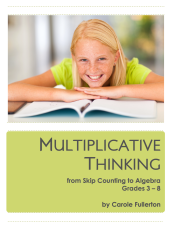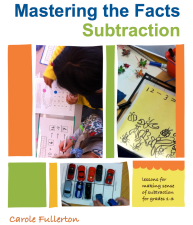NEW Resource! Proportional Reasoning in Grades 4-8
 For those who have been patiently waiting (and lovingly nagging!) I am happy to announce the publication of my newest math teaching resource: Proportional Reasoning in Intermediate for Grades 4-8, available now through my online store.
For those who have been patiently waiting (and lovingly nagging!) I am happy to announce the publication of my newest math teaching resource: Proportional Reasoning in Intermediate for Grades 4-8, available now through my online store.
This resource for teachers of Grades 4 to 8 presents more than 250 pages of open-ended lessons, meaningful practice, games, literature connections and a wealth of problem-solving contexts for supporting students to make sense of fractions, decimals, percentages, ratios and proportions. Designed for today’s diverse classrooms, this resource offers a range of tasks to promote proportional thinking through intentional development of mathematical language and the use of key manipulatives. Colour tiles, Cuisenaire rods and tangrams are used to model and make connections within and between concepts.
In the first section of the resource, students will explore three models – set, area and linear – for representing and describing, comparing and ordering fractions. Students will learn to convert between fractions, decimals and percent and to apply these skills to problem situations, including measurement, tax, discounts and data management. Next, students learn to add and subtract fractions, to solve proportions using a range of strategies (involving both mental math and the appropriate use of technology) and then finally to multiply and divide fractions.
Assessment tools are threaded throughout the resource to allow teachers to keep track of student progress and to make instructional decisions.
Proportional reasoning IS the math we do every day. This resource provides an access point for all.
Enjoy!
Maintenant disponible en français!
Finally … French translations of my latest books are now available!
Je viens de traduire mes deux ressources de bonnes questions — “A Year of Good Questions for Grades 2-4” et “A Year of Good Questions for grades 5-8” — afin que mes collègues d’immersion aient des ressources françaises avec lesquelles travailler. Merci pour vôtre patience!
In these new French translations of the English originals, you’ll find more than 200 open-ended and engaging problems for french immersion students from primary through middle school. All are posed in French and explore important mathematical concepts across the grades.
 The first book: Bonnes Questions: Une année de bonnes tâches mathématiques pour les élèves de 2e à 4e is suitable for late primary students (grades 2-4) and features operational tasks, measurement tasks and pattern tasks of increasing complexity, posed in French.
The first book: Bonnes Questions: Une année de bonnes tâches mathématiques pour les élèves de 2e à 4e is suitable for late primary students (grades 2-4) and features operational tasks, measurement tasks and pattern tasks of increasing complexity, posed in French.
 The second volume: Bonnes Questions: Une année de bonnes tâches mathématiques pour les élèves de 5e à 8e is perfect for middle school immersion students (grades 5-8), with a focus on proportional reasoning, algebraic thinking as well as operations on integers, fractions and decimals to name a few.
The second volume: Bonnes Questions: Une année de bonnes tâches mathématiques pour les élèves de 5e à 8e is perfect for middle school immersion students (grades 5-8), with a focus on proportional reasoning, algebraic thinking as well as operations on integers, fractions and decimals to name a few.
Engaging problems and choice make these volumes the perfect conversation starter for our immersion classrooms, promoting oral language development and mathematical thinking …en même temps!
All are available from my online store.
Carole
Good Questions: A Year of Open-Ended Problems for Grades 5-8
I am pleased to say that — beyond spending every day on the water this summer — I DID manage to create a new teacher resource for my intermediate colleagues.
This time, it’s a stand up calendar of problems — one for every day of the school year!
This compact but potent book comes with an easel so you can set it up on your desk and flip from one rich problem to the next, posing open-ended questions of your intermediate students.

Good Questions: A Year of Open-Ended Tasks is a problem-a-day resource that includes
rich tasks ideal for grades 5, 6, 7 and 8. Organized by topic and structured in problem sets of 5 or more, this simple to use teacher resource includes 210 mathematically important questions to engage your students in deep thinking. For only $25, it’s a perfect back-to-school gift for yourself!
Proportional reasoning, measurement, operations and algebra are featured in this calendar of problems. Each one engages students in thinking flexibly, critically and creatively in the face of important and challenging mathematics.
Visit my online store at mindfull.ecwid.com to order.
Let the problem-solving begin!
Carole
A fun and thought-full division game…
Hello all.
I thought it was time to post another game for those of you who are looking to support your intermediate students. This is another classic game from BEAM. It’s called the Game of Remainders — but don’t be fooled! It’s about far more than simple division. There are connections to be made to skip counting and the multiples here that are worth talking about!
 As a tool for thinking and for identifying the important patterns inherent in this game, consider giving students a hundred chart to begin. Have them shade or highlight all the multiples of 6 (6, 12, 18, 24, 30, 36, etc) before playing the game.
As a tool for thinking and for identifying the important patterns inherent in this game, consider giving students a hundred chart to begin. Have them shade or highlight all the multiples of 6 (6, 12, 18, 24, 30, 36, etc) before playing the game.
Then, as they land on a number in the wheel (like say 49), they can refer to the chart and see that the number 49 is not coloured, so it’s going to have a remainder. Looking further, the will notice that it is in fact one more than a multiple of 6, which means there will be 1 remainder.
Fun, right?
Be sure students gave a chance to talk about what they’re noticing in the chart as they use it. The more we describe our thinking, the clearer it gets and the more connections we make!
I’ve made a few other versions of this game if you’re interested in downloading them. They follow the same format, but address divisibly of 3, 4 and 5.
Three in a line – remainders game – 3
Three in a line – remainders game – 4
Three in a line – remainders game – 5

And, if you’re looking for a resource to help you in your teaching of division, consider this one: Fair Shares – Teaching Division in Grades 4-7. It’s available from my on-line store.
All the best as we count down to summer!
Carole
Calculation Nation – Rich, online math games for practice
The NCTM (National Council of Teachers of Mathematics) has a set of online math resources worth looking into. Check out Calculation Nation (calculationnation.nctm.org/) for a series of challenging and engaging games for students in grades 3-9. Students will explore factors, prime and composite numbers, multiplication, area and perimeter, operations on fractions, solving algebraic equations and geometric concepts like tessellations and symmetry. Students can play these games against the computer or even against another player somewhere else in the world!
A simple log in is all that’s required in order to play.
I’m sure you’ll find some worthwhile tasks in this set of carefully crafted materials. Enjoy!

Fair Shares – Teaching Division in Grades 4-7
I am pleased to announce the publication of my latest teacher resource book called Fair Shares – Teaching Division in Grades 4-7. The book features tasks, games and problems for intermediate aged students focussed on making sense of division.
Through stories, models, pictures and words, students are introduced to the idea of division as sharing and division as grouping. Lessons include opportunities for talk, for exploration and for practice in the form of games and engaging tasks across the grades. The lesson sequences are designed to address division of whole numbers and decimal numbers, to make meaningful connections to fractions and decimals in context and to support students in seeing patterns in quotients. Lessons map out how to use manipulatives to model division situations, and literature connections to introduce great division contexts. Match to the WNCP curriculum, Fair Shares – Teaching Division in Grades 4-7 outlines a range of assessment tools to allow teachers to gather evidence – quickly and without stress on the part of the students – to show what their learners know and can do.
Thank you, as always, for your support.
Carole









